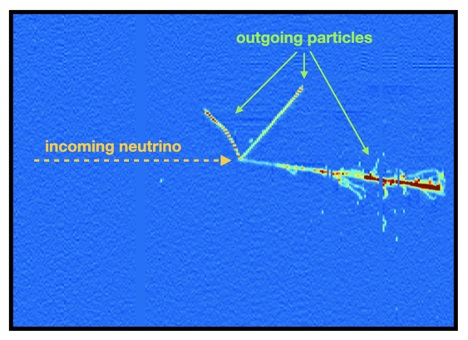Jul 27 2020
At Fermilab’s ArgoNeuT collaboration, researchers have used new approaches to successfully measure neutrino interactions, with the ultimate aim of identifying electron neutrinos.
 An electron neutrino interacts in the ArgoNeuT detector. The incoming neutrino is invisible to the detector until it interacts with an argon nucleus to produce charged particles, which traverse the detector. Image Credit: ArgoNeuT.
An electron neutrino interacts in the ArgoNeuT detector. The incoming neutrino is invisible to the detector until it interacts with an argon nucleus to produce charged particles, which traverse the detector. Image Credit: ArgoNeuT.
This means is crucial for subsequent experiments that endeavor to gain insights into the difference between matter and antimatter in the realm of neutrinos.
Hosted by Fermilab, the international Deep Underground Neutrino Experiment (DUNE for short) will offer a solution to one of the most crucial open questions in the field of particle physics: To what extent does the behavior of neutrinos differ from that of antineutrinos?
The solution is based on the understanding of the interaction of electron neutrinos in detectors such as ArgoNeuT and DUNE across a wide range of energies.
Neutrinos are concurrently the most abundant and one of the most elusive particles in the universe. A specifically intriguing aspect that particle physicists analyze in-depth is how often each of the three familiar types of neutrinos transforms from one type into another as each moves through time and space.
While playing catch with friends, an individual throws a baseball, only to make the friends catch a softball, or a Wiffle Ball, and the individual does not know what they are going to catch until it is already in their hands.
In such a hypothetical game of catch, one might wonder whether the friends will catch a softball, a baseball, or a Wiffle Ball if the person throws a baseball. Similarly, physicists starting with a muon neutrino wonder how often will that be an electron neutrino by the time it interacts in their detector.
To find an answer to this question, physicists develop beams of one kind of neutrino, position a detector a certain distance away, and then count the number of each type of neutrino observed by the detector to ascertain the rate at which each kind of neutrino transforms into another over that distance.
However, for accurate counting of neutrinos, particle physicists must first understand how to identify the kind of neutrino that interacted in a detector.
ArgoNeuT—a small, high-resolution neutrino detector located at Fermilab—gathered data for six months just about a decade earlier. Detectors such as ArgoNeuT capture high-resolution “pictures” of neutrino interactions.
The neutrino itself is almost invisible to the detector, and a majority of them pass straight through without ever interacting. However, if a neutrino rarely interacts with one of the argon atoms in ArgoNeuT, it can form other recognizable particles.
Use information related to each particle that is formed when a neutrino interacts, particle physicists can identify the kind and properties of the original neutrino.
The type and number of particles synthesized during a neutrino interaction are also based on the neutrino’s energy—neutrinos that have higher energy synthesize more particles. Consider the scenario of breaking right at the start of a game of pool. The harder the white cue ball is hit, the more the other balls tend to scatter all over the table.
In neutrino physics, one of the biggest challenges is to develop automated algorithms to categorize neutrino interactions. Since neutrinos interact very rarely, it could be highly challenging to differentiate the neutrino interactions an individual tries to count from other interactions.
Of the almost four million “pictures” gathered by the ArgoNeuT detector, only around 100 images include the electron neutrino interactions that were analyzed in ArgoNeuT’s most recent study, which offers new techniques to identify electron neutrinos in detectors such as ArgoNeuT.
Although researchers have studied interactions of muon neutrino with argon, there is still a dearth of data that helps understand electron neutrino interactions, specifically at higher energies.
However, this is precisely the neutrino energy range that will be most applicable for DUNE, the goal of which is to find solutions to several of the remaining open questions that particle physicists have with respect to neutrinos (and generate new, interesting questions).
The techniques created in ArgoNeuT can be expanded and used for existing and future experiments over a wide array of neutrino energies.
Journal Reference:
Acciarri, R., et al. (2020) First measurement of electron neutrino scattering cross section on argon. Physical Review D. doi.org/10.1103/PhysRevD.102.011101.